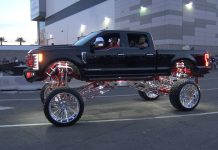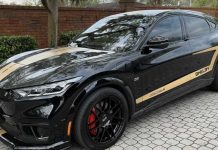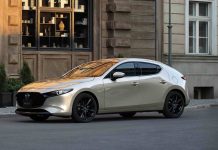Almost ten years ago, back in ’03, I drove one of the first Nissan Muranos. It was Dennis Kucinic to Barack Obama – or Ron Paul to Mitt Romney.
Something different for once.
At that time, SUVs were … SUVs: Pick-up trucks modified with enclosed beds and seats for passengers. They had room and they had utility – but they were about as sporty as Color Purple Oprah in a track suit.
Well, what if you took a sport sedan, raised it up off the ground a little – but not so much you killed the handling? Gave it a swoopy – rather than boxy – shape? Built if for adults who like to haul ass – as opposed to hauling kids? Nissan had this thought first – or at least, was the first to transform the thought into a production vehicle. Viola – Murano.
Everyone else – literally – rushed to copy it.
Which is why, today, it’s no longer the standout it was back in ’03.
No doubt that’s why Nissan added the Cross Cabriolet to the Murano lineup about a year ago. It was still a Murano in name, but with radically different sheetmetal – including no sheetmetal above your head – and two big doors instead of four normal sized ones.
Like the original Murano back in ’03, there was nothing else like it on the road. Unfortunately for Nissan, this time everyone else didn’t rush to copy it. The CrossCab has been a disaster of Aztekian dimensions (it was awarded the Most Disliked Car of 2011 raspberry by Forbes magazine) and – as this review went to press in early December 2012, Nissan had published no information at all about the 2013 CrossCab on its media site.
A cancellation announcement seems imminent.
And the regular Murano? It’s still an appealing vehicle, but it doesn’t fit 2013 as well as the original did 2003.
It’s also got competition – which it didn’t have back in ’03.
I’ll explain.
The Murano is a mid-sized, FWD/AWD crossover SUV that’s a bit smaller overall than other mid-sized crossovers – several of which offer a third row, which the Murano does not.
The Murano can’t take seven – but it’s got ample space for five.
Base price for the FWD Murano S is $30,340. A top-of-the-line AWD LE starts at $39,530.
There’s also the Cross Cabriolet convertible Murano – well, maybe there is. Nissan hasn’t issued a peep about the 2013 model. The absence of any press materials for 2013 on the Nissan media site strongly suggests there may not be a 2013 CrossCab. So if you want one, better hurry. There are probably still a few new 2012s available.
LE Platinum Edition (and SL Muranos with the optional Navigation Package get a Moving Object Detection system that prompts the driver with a chime and warning light when – you guessed it – it detects an object in the vehicle’s path. Lane Departure Warning and Blind Spot Warning are also on the docket.
In addition, there’s a Value Package for Murano SV trims which bundles a power liftgate, GPS navigation and a premium Bose 9 speaker audio rig.
Otherwise, the ’13 Murano is a carryover.
WHAT’S GOOD
The original. All that made it good back in ’03 is still good in ’13.
Sporty, useful – fun to drive.
Peppy (and standard) 260 hp 3.5 liter V-6.
High-end interior – and high-end available equipment.
Unique Cross Cab variant. Roomiest, tallest-riding four-seater ragtop on the road.
WHAT’S NOT SO GOOD
Peppy V-6 drinks a lot of gas. Or rather, too much gas for 2013.
Competitors like Ford Edge cost less ($27,525 to start), offer more power (up to 305 hp) and significantly better gas mileage.
The “unique” CrossCab. It’s over-heavy, over-priced – and has cowl shake like a ’68 Pontiac.
UNDER THE HOOD
All Muranos – including the Cross Cab – come standard with a 3.5 liter V-6, though the Cross Cab’s version is rated 5 hp stronger (265) vs. the regular Murano’s 260.
The Cross Cab’s version of the 3.5 V-6 also wants premium fuel – while the 260 hp engine is ok with regular unleaded.
The standard – and only – transmission is a continuously variable (CVT) automatic transmission. The regular Murano offers FWD or AWD; the Cross Cab comes with AWD standard.
Expect a 0-60 time around 7.4 seconds for the lighter FWD Murano – and about 8.2 seconds for the significantly heavier (and thirstier) Cross Cab. EPA gives it a 17 city, 22 highway rating vs. 18/23 for the AWD-equipped conventional Murano.
A FWD Murano does a little bit better than that, earning an 18 city, 24 highway peg.
Still, all versions of the Murano are thirsty – and that may be one of this model’s weakest selling points today vs. yesterday. In 2003, gas cost about half what it does now. So, it costs about twice as much to feed a Murano now vs. then. Ford has addressed this issue by offering a turbocharged four-cylinder “EcoBoost” option in the Edge – and so equipped, the Ford is capable of 30 MPG on the highway and 21 in city driving. The turbo’d Edge isn’t as quick as the Murano – zero to 60 takes about 8.4 seconds – but probably that lost second on the dragstrip doesn’t matter as much to today’s gas price-conscious buyers as the gained 6-7 MPG on the road.
Edge also offers a 3.5 liter, 285 hp V-6 that outmuscles the Murano’s V-6 while also delivering better MPGs: 19 city, 27 highway with FWD and 18 city, 25 with the optional AWD system. And you can upgrade from there to a 305 hp V-6 (in the Edge Sport) that still manages a not-terrible (for 305 hp) 19 city, 26 highway (FWD) and 17 city, 23 highway with AWD.
Also: If you can handle a slightly smaller vehicle, there are vehicles like the new Mazda CX5 out there – capable of 35 MPG.
In 2003, nothing else looked like the Murano. Ten years later, the Nissan’s bulgy, linebacker squat has been copied by almost everyone else to one degree or another.
But few competitors have successfully copied the Murano’s unusually athletic (for a crossover SUV) driving dynamics – including the Ford Edge, which is more of a straight-liner and luxury-tourer than the Nissan. Both accelerate smartly – but when the road turns twisty, it’s the Nissan that has the edge.
Both these vehicles sit almost 8 inches off the ground (the Ford slightly higher at 7.9 inches vs. 7.4 inches for the Nissan) and ride on tall tires (20 inchers are available) but one of them – the Murano – doesn’t convey urgent warnings you’re violating physical laws when you lean on it in a corner. It is much more poised during such maneuvering than the Edge. That extra half-inch of air between the pavement and the frame probably accounts for some of this. Also the Ford’s appx. 200 pounds of extra unsprung mass (4,050 lbs. empty vs. 3,841 lbs. for the Murano).
Higher-off-the- ground – and heavier – is not the hot ticket for high-speed cornering.
The Murano also has excellent, Maxima-like steering – weighted just right and very precise, with no slop on center or anywhere else. The Ford’s isn’t bad. It’s just not very sporty.
There is a gravel road near me – one of those great (because slightly scary) country roads just wide enough for a car and a half – with lots of blind curves and a no-guardrail drop off to the right, where occasionally through the foliage you’ll spot a rusted relic, far down below. Roads like this are the Murano’s playground. It has the ride height to deal with the almost-off-road terrain; the dips and potholes that rip pieces off the lower things of cars. But unlike the typical truck-based SUV (or car-based crossover SUV), the Murano also has the suspension to let you drift corners, control-sliding through the gravel apexes – then hard on the gas for the uphill.
If you get some air, no sweat. It won’t bottom out. Don’t ask how I know…
Nissan also goes easy on the Nannyism. The traction/stability control stays in the background unless you’re really hauling the mail. And Nissan vehicles are the only vehicles left on the market (as far as I can tell) that do not harass you with a buzzer that won’t shut up if you don’t “buckle up for safety.”
The only driving complaint I can gin up is the tunnel-view rearview view – a result of the liftgate’s relatively small glass area and the shape of that glass. But you learn to use your side mirrors and adjust accordingly.
I generally am not a fan of CVTs because of the racket they usually make and their thrashy operating characteristics – especially at WOT. But Nissan builds an excellent CVT. It’s quiet and mimics the operation of a regular automatic under most conditions. Only at WOT can you tell it’s a CVT – because the engine revs climb to near redline and stay there as long as you keep your foot in it.
This CVT also has seven “gears” (engine RPM points, really, because a CVT doesn’t have individual gears like a regular automatic or manual transmission) that can be toggled through in a manual/sport mode for when you want to hold a particular RPM range at a given road speed, rather than let the transmission run through its range automatically – as for example, when you’re descending a long grade and want some engine braking effect.
The Edge – though a newer vehicle – still only has a six-speed automatic.
The real shame is the continued absence of a manual transmission on the Murano’s list of options. Nissan is a very driver-minded company (like BMW used to be) and has among the sportiest lineup of cars available.
But it has also been disappearing manual transmissions.
First Maxima – the original four door sport sedan. It used to have a six-speed manual. Not anymore. Not for awhile, either. Then Altima, which still offered a six-speed manual – until this year’s (2013) redesign. Murano has never been available with a stick, of course. But that doesn’t mean it shouldn’t be available with one.
Blame fun-killing traffic everywhere – which is killing demand for manual transmissions.
AT THE CURB
The regular Murano’s a familiar face – still attractive but no longer the head-turner it was back in ’03. The chief draw is not so much the curb appeal but the handsomely appointed interior, which remains four-seater intimate (though you can carry five) and which looks and feels luxury – not mid-priced. It compares very favorably to its Infiniti cousin, the FX35. Each panel seems carefully fitted in place – not popped into place. Glove-soft leather; liquid-looking chrome accents. But unlike the FX, the Murano doesn’t cost $43k to start.
Unfortunately, the Cross Cab does. (Well, did.)
(Well, did.)
The price is (or was) not entirely unjustified. After all, you’re getting what amounts to a full-custom. The bodywork is radically different – two doors, no roof. And like the original Murano back in 2003, the CrossCab is the chiropracter’s friend – everyone turns to look. (They may not all smile… .)
Driving it is an interesting experience. There’s no other convertible coupe on the road with such a commanding view – unless you’re driving a 1970 Bronco. But the Cross Cab doesn’t have metal floors and no-give seats and amenities that are limited to a cigarette plug, wing vent windows and an AM radio. It comes loaded with everything – including the AWD system that’s optional in the regular Murano – plus the 20 inch wheels, full-leather interior, GPS navigation, premium Bose audio rig with 9.4 Gig music storage hard drive. Plus the extra 5 hp (which helps with the extra weight) and, of course, the power-folding soft top.
The other thing you get in the CrossCab is backseat room.
There is no other vehicle on the market that’s both a crossover SUV and a convertible and has such adult-friendly backseats. The Chrysler 200 is one of a very few four-seater convertibles that has non-waterboarding backseats – but it’s a car, not a crossover. The Range Rover Evoque comes as a “coupe” – but you don’t want to be in the back seats – and you can’t drop the top.
So, the Cross Cab is unique in form and function. But it’s pricey – and has wicked cowl shake, a fairly common problem with convertibles because you’ve lopped off the roof – which ordinarily ties the car’s structure together.
Like the Edge, the regular Murano has four doors and two rows of seats and can handle five people reasonably – four comfortably. But it’s much more biased toward the people riding up front, who get 43.6 inches of legroom vs. 40.7 in the Ford. However, people riding in the Ford’s backseats get 39.6 inches of legroom vs. 36.3 in the Nissan. Front and rear seat headroom in both vehicles is almost identical (40.1 inches up front for the Murano vs. 40.0 for the Edge; 39.4 inches in back for the Murano vs. 39.3 in the Edge).
The Ford has a slight edge when it comes to cargo capacity: 68.9 cubic feet (max) with the second row folded vs. 64 for the Nissan.
I’m nervous about the Murano’s future – because I’m nervous about gas prices. The hungry mutha’s almost 22 gallon tank costs nearly $70 to fill at current prices (about $3.20 per gallon for regular unleaded). If the price of gas climbs to $4 this summer, it’ll be nearer to $90.
Back in ’03, you could fill up a Murano for less than $40. And back in ’03 people had jobs. Today, an alarming number of people don’t have jobs – and those who do have less disposable income than they used to.
I’m guessing there’s a redesign in play for next year (2014) by which time the current model will have been more or less the same for about five years (since the last major restyle in 2008 for the ’09 model year). My bet is there will be a four cylinder option, as in the Edge.
Big V-6s with big appetites are going the way of the Dodo.
Unlike back in’03 there are now a number of interesting to look at, interestingly laid out medium-sized crossovers on the market – including the Ford Edge. But the Murano’s still a cut above in terms of how it drives – and the Cross Cab’s about as interesting as interesting gets.
Even if it’s already a goner.














Looks fantastic.The datsuns are getting better all the time. If Americans keep buying and jacking Japan’s forex reserves beyond the 1.3 Trillion $ they’re already at now, I hope we’re selling them 3rd generation Nuke plants and some frack gas and oil.
It’s one thing to implode your own economy, we should at least pay up before we all jump off the fisal lemming cliff of wiley coyote valley.
Meep. Meep.
So many mid sized, look and drive alike CUVs. Perhaps the most boring type of mainstream vehicle on the market.
Do consumers really want these things? Or do manufacturers give them so few choices? How many buyers really use both the extra ground clearance and cargo capacity?
Although there is nothing about the Murano that I specifically dislike, it is a car I would never, ever buy.
If I ever again buy something that big and jacked up, it is going to be (if not a truck,) a REAL SUV.
Gosh I wish that station wagons would become popular once again!
The Murano’s among the few that’s actually set up to driven – and pretty much the only one in its price/size range.
The first one (and subsequently) sold very well – but it’s slackened off. I see the market re-orienting toward slightly smaller – but much more efficient (and less expensive) crossovers like the CX5.